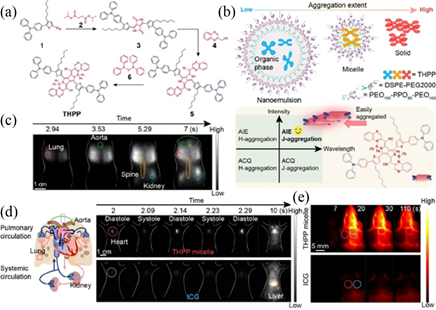Organic dyes emitting in the second near-infrared (NIR-II, 900-1700 nm) window, with high molar extinction coefficients (MEC) and quantum yields (QY) in aqueous, are essential for in vivo bioimaging and biosensing. In this work, we developed a dibodipy-based aggregation-induced emission (AIE) fluorescent probe, THPP, to meet this aim. THPP exhibits a high MEC and has intensified absorption and emission in J-aggregated state, which significantly enhance the fluorescence intensity (≈55 folds) and extend the maximal absorption/emission wavelengths to 970/1010 nm in NIR-II region. Based on the bright THPP, imaging with a high frame rate (34 frames per second) at a deep “valid penetration depth” up to 6 mm can be achieved. This enabled simultaneous and dynamic imaging of vasculatures and deep tissues. Besides, we succeeded in monitoring the respiratory rate of acute-lung-injury mice and tracing the collateral circulation process with a high frame rate.

Fig. 1 (a) Scheme for the simplified synthetic route of THPP. (b) Scheme for the nanoemulsion, micelle and solid of THPP represent different aggregation extent, respectively (above) and quadrantal diagram for the special AIE and J-aggregation feature of THPP (below). (c) NIR-II imaging at 17 FPS from dorsal view of a nude mouse over time. (d) NIR-II imaging at 17 FPS from dorsal view of a nude mouse over time. (e) Time-lapse images of mice cerebral vasculature with carotid arterial thrombosis to the left hemisphere, after administration of THPP micelles and ICG.
https://onlinelibrary.wiley.com/doi/10.1002/anie.202012427
